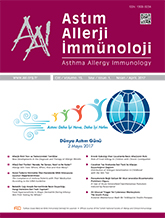


Allergic rhinitis (AR) is one of the most common chronic diseases in all age groups. It is an IgE-mediated allergic inflammation of the nasal airways and is characterized by sneezing, swelling and inflammation of the nasal mucosa as well as itchy and watery eyes. It is a global health problem and a burdensome disorder affecting many people from childhood to adulthood. The prevalence of childhood AR shows wide variation throughout the world, ranging from 0.8 to 45%. The prevalence rates for different regions of Turkey ranges from 2.9 to 44%. The aim of the present review is to provide an update on AR treatment and diagnosis. Because of its burden on patient`s lives and its impact on asthma, AR should be taken care of properly with effective and safe treatments. Second-generation antihistamines and intranasal steroids represent the milestone of AR therapy. New formulations of available drugs (rupatadine oral solution, ebastine fast-dissolving tablets, combination of intranasal fluticasone propionate and azelastine hydrochloride), recently discovered molecules (ciclesonide, bilastine, roflumilast, etc.), immunologic targets (omalizumab) and unconventional treatments (homeopathic treatments) are representing new frontiers in AR management. An accurate diagnosis of AR is also crucial to increase treatment success. Further promising improvements in diagnostics are expected from recombinant allergen diagnostics identifying particular molecules of risk. Purified native or recombinant allergens, identifying the individual molecules to which patients are sensitized, can be determined by molecular or component resolved diagnostics. These may decrease the need for provocation testing and improve the specificity of allergen immunotherapy. Different methods to measure nasal nitric oxide (nNO) levels are currently being revealed. Decreased nNO concentration is also typical of cystic fibrosis, even though nNO is not as low as in primary ciliary dyskinesia. The clinical utility of nNO remains to be established in upper airway disorders such as AR.